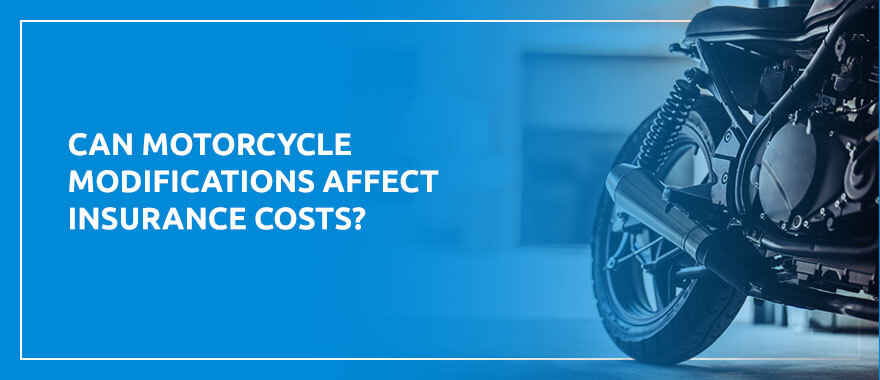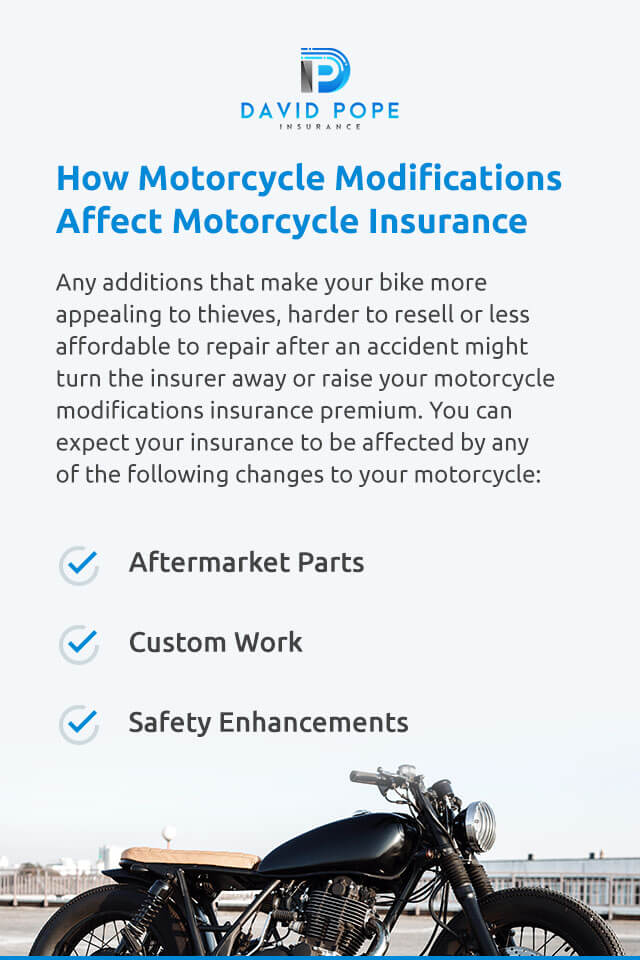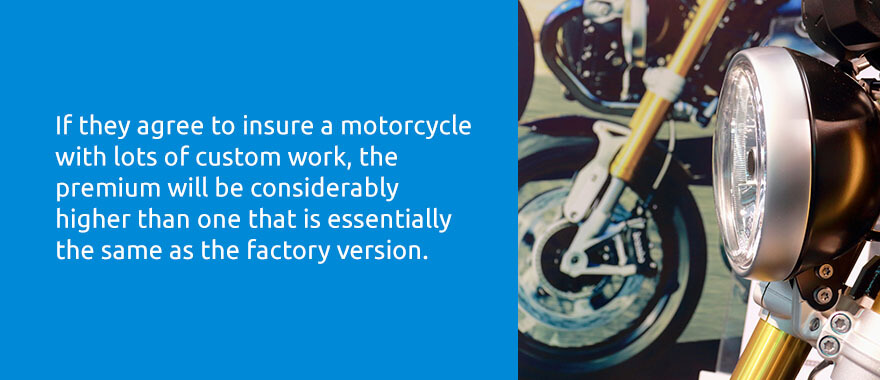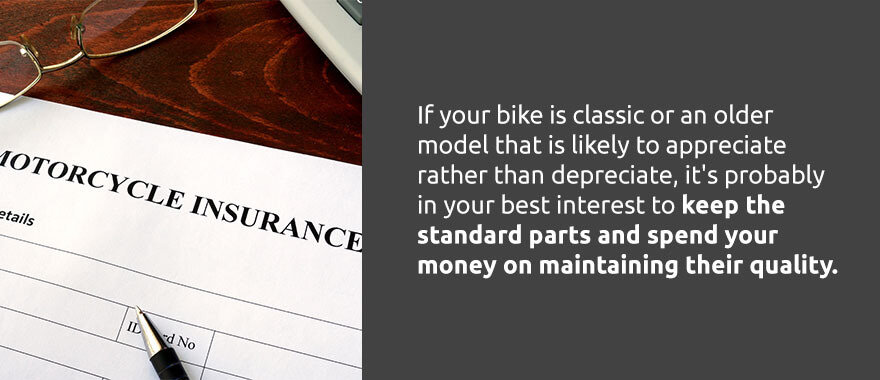
As a motorcycle owner, you understand the exhilaration of taking to the open road and cruising on your bike all afternoon. What you’re not exhilarated about is motorcycle insurance. You know you need it, but obtaining the right motorcycle insurance for your bike can be a headache, especially if your motorcycle is modified and customized.
Motorcycle modifications often impact your insurance premium, for better or worse. This guide to motorcycle modifications insurance will help you determine how your upgrades could affect your policy so you can get the best coverage at the lowest price.
Each change you make to your bike can potentially impact your insurance premium. Your insurer will generally include approved manufacturer accessories as standard in your policy, but custom work could significantly affect your insurance costs. Upgrades can increase your payments or lower them, depending on the type and impact of the change.
Motorcycle modifications are considered different liabilities than accessories. Insurance companies may define these two categories differently, but the essential difference between these types of upgrades is their effect on how your bike works:
Your insurance company may view these and other additions differently, so it’s essential to check with them to learn how your coverage might change if you add them.
In contrast to safety-improving or appearance-enhancing accessories, modifications usually improve your motorcycle’s power or increase its speed. Some purely cosmetic changes also count as modifications, though these are less likely to improve your bike’s safety or protect its condition.
Examples of motorcycle modifications that will likely impact your premium include:
Some additions that don’t qualify as accessories may not count as modifications either. If you replace old or damaged components with the same or similar parts that your bike came with out of the factory, your insurance will likely remain the same. Consumable parts like fuel and oil filters also don’t count as modifications.

Any additions that make your bike more appealing to thieves, harder to resell or less affordable to repair after an accident might turn the insurer away or raise your motorcycle modifications insurance premium. You can expect your insurance to be affected by any of the following changes to your motorcycle:
Motorcycle aftermarket parts are replacement parts not manufactured by or associated with the bike’s original manufacturer. Third-party manufacturers sell these parts as alternatives to the original equipment manufacturer’s products. Aftermarket parts are popular for custom motorcycle work because they are more readily available and in more variety.
Because these parts are most often used in custom motorcycle work, which is costly to replace, they may give your insurer second thoughts about keeping your premium the same. Aftermarket parts are also usually sold without a warranty. This means that if your bike’s aftermarket parts get damaged or stolen, you or your insurance have to pay full price to replace them.
Many motorcycle owners enjoy working on their bikes themselves. Whether you’re out in the garage fixing up your bike every weekend or you take it to a mechanic for a one-time enhancement, adding custom work can make your insurance jump.

Unique paint jobs can cost thousands of dollars, depending on the details. Installing a one-of-a-kind engine could also set you back a few hundred to a few thousand dollars. Most insurance companies are reluctant to insure bikes that would be so costly to replace. If they agree to insure a motorcycle with lots of custom work, the premium will be considerably higher than one that is essentially the same as the factory version.
With 84,000 motorcyclist injuries in 2019, it’s no wonder why insurance companies love safety features. The safer your bike is, the less likely you are to file an insurance claim — or the less expensive your claim is likely to be. A safer motorcycle lowers their risk, so they’ll look for any modifications or accessories that increase your bike’s protection during an accident.
Adding safety features might not change your premium at all. These “acceptable” modifications might include a Scottoiler, which lubricates your chain and prevents it from snapping, and tank pads, which protect the fuel tank from being scratched.
Safety features could also lower your payments, depending on your insurer’s policy. For example, upgrading to LED turn signals makes your motorcycle more visible at night. Changes like this that objectively improve your bike’s safety could positively impact your premium.
The change to your premium depends on several factors. Most insurance companies include a certain amount of motorcycle accessories insurance with your base policy. However, it’s often very easy to surpass this included coverage. You can usually purchase additional motorcycle accessory coverage in increments, depending on the amount of insurance your bike needs. After all, it’s taken a lot of time and investment to get it to be the one-of-a-kind bike that reflects your personality.
Insurance companies calculate premiums based on the amount of risk they assume by covering you. Any modification to a motorcycle that tells your insurance provider you’re more likely to take risks will likely increase your premium. This could include changes that improve your bike’s speed, engine power and even sound.
Modifications that make your bike unique and challenging to replace also mean that it will cost more to rebuild after an accident, so the cost of your collision insurance could be significantly higher. An increased premium is undoubtedly worth the cost when you compare it to the expenses you might rack up if you need to replace all aftermarket parts and redo all custom work.
However, adding security devices to your bike could lower your insurance premium instead. According to the most recent report from the National Insurance Crime Bureau, nearly 41,000 motorcycles were stolen in 2019. Adding security devices can prevent your bike from being stolen and help you recover it if it is. Insurers see security devices as slashing their risk, so they will likely look more favorably on these additions.
Examples of safety enhancements that could potentially lower your motorcycle coverage include:
You should absolutely tell your insurer about your motorcycle modifications. An insurer may not need to see routine replacements like oil filters, but you need to report any addition that changes the motorcycle from its factory form right away.
Without the right amount of motorcycle modifications insurance, you can be at risk for some immense costs. If you don’t report your changes for coverage, your bike may have $3,000 worth of additions that your insurer won’t cover after an accident. You can only be insured for the reported value of your motorcycle, which means that you might have to handle the rest of the repairs out of pocket.
It is essential to state the total value of your motorcycle when signing up for coverage and report the cost of each addition you make later. Even better, find out your insurer’s exact practices before you make any modifications. Generally, an insurance company will define what they consider modifications and what could raise your premium in the policy’s paperwork. However, you might be surprised by their response.
You should also disclose any accessories, as your insurer might have a different policy about upgrades you might assume would not affect your premium. What you carry on your rides could also affect your personal belongings and carried contents coverage.
If you fail to report the accurate value of your motorcycle, your insurer also has the right to refuse coverage. It’s essential to be open about every change to your bike so you can secure the right coverage.
You can decrease your motorcycle modifications insurance through several strategies. Here are a few of the best ways to get better-valued motorcycle coverage:
Including safety enhancements on your bike is one of the best ways to snag a lower premium on your motorcycle accessory coverage. The most reliable features are GPS trackers and chains, as these are much more difficult for a thief to cut off.
Before you get a tracker, consider how often you drive your bike. Some GPS trackers operate on a subscription basis and provide access to a 24/7 support center. If you ride your motorcycle often enough to warrant this expense, these kinds of trackers can be beneficial. You should also look for trackers with their own battery source because those that rely on your motorcycle for power could drain its battery.
Better drivers are safer drivers. Many insurance providers will discount you for taking an advanced motorcycle riding course. This is because investing in your abilities as a rider demonstrates that you take safety seriously. Even if you’ve been driving for several years, taking a course can decrease your premium. These courses aren’t free, but they can save you money in the long run.
Having a poor driving record is almost guaranteed to increase your premium. Drive safely, always wear your helmet and do your best to avoid accidents. Having a good driving record — on your motorcycle and for any other vehicle you own — can qualify you for a safe driver discount.
Whether or not you should modify your bike depends on several factors. If you plan to sell it within a few years, a motorcycle with lots of custom parts or a unique paint job might be challenging to resell. In this case, keeping the factory-standard parts is more likely to give you a fast and easy sell.
You might plan on keeping your bike for a long time, and then resale doesn’t matter as much. You could always keep your standard parts after a modification and refit your motorcycle when it comes time to sell.

If your bike is classic or an older model that is likely to appreciate rather than depreciate, it’s probably in your best interest to keep the standard parts and spend your money on maintaining their quality. Other motorcycle enthusiasts will appreciate your bike’s original condition.
Keep in mind that the number and type of modifications you make could make your bike less safe or more costly to repair. The one-time cost of adding extended forks or replacing the frame could turn into much more expensive continual repairs. You also don’t want to drive an unsafe motorcycle, so think carefully about what changes you really want.
Modifying your bike could also cause difficulties obtaining insurance or holding on to your current premium.
While many insurers might shy away from providing coverage for a custom, modified motorcycle, others take a flexible approach to policy-writing. If you can’t bear the itch the change your bike and make it totally yours, look for an insurance provider who can offer you coverage as unique as your needs.
An insurance provider that offers custom motorcycle insurance will be able to work with you to get the coverage you need at the best rates possible.

If you need motorcycle modifications insurance for your unique bike, David Pope Insurance Services, LLC is here to help. We strive to provide the best motorcycle insurance in Missouri and beyond, giving you a fast and painless experience and flexible quotes suited to your needs.
Over our 15 years in business, we’ve developed experience and relationships to provide drivers and homeowners with the protection they need to have peace of mind. Ensure you have necessary insurance coverage with David Pope Insurance. Request a quote today to learn more about how our affordable insurance policies help our clients.